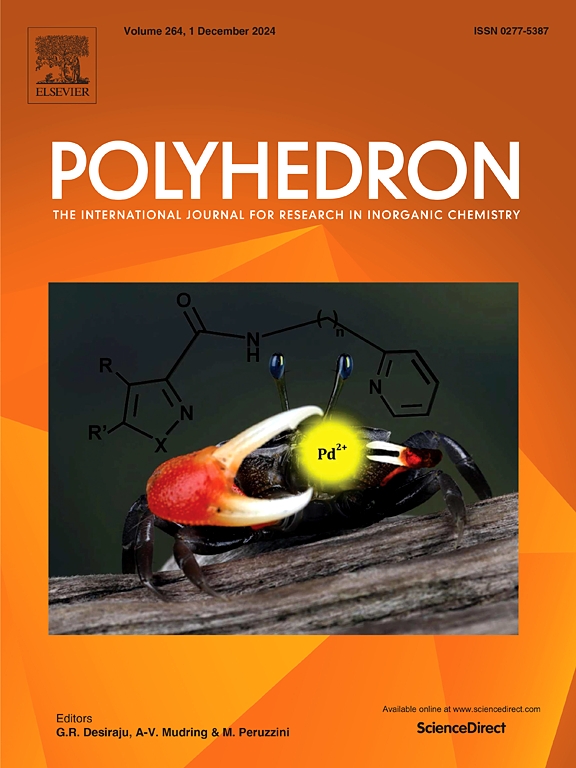环金属化铱(III) -鲁robustine配位化合物作为高效抗癌剂
IF 2.4
3区 化学
Q2 CHEMISTRY, INORGANIC & NUCLEAR
引用次数: 0
摘要
顺铂(CPDC)是一种铂配合物,是一种高效的抗癌药物,但其毒副作用促使研究人员寻找非铂金属的替代配合物。我们设计、合成并充分表征了四种环金属化铱(III)配位化合物,它们分别与两种环金属化2-苯基吡啶(H-PPY1)或3-甲基-2-苯基吡啶(H-PPY2)配体和两种罗布汀(H-Rob1)或8-羟基喹啉(H-Rob2)功能化的伯配体配位:[Ir(Rob1)(PPY1)2]·CH3OH (Ro1), [Ir(Rob1)(PPY2)2]·CH3OH (Ro2), [Ir(Rob2)(PPY1)2] (Ro3), [Ir(Rob2)(PPY1)2] (Ro3)和[Ir(Rob2)(PPY2)2] (Ro4)。采用细胞计数试剂盒-8 (CCK8)检测其对耐cpdc卵巢SK-OV-3/DDP (crSK3)、卵巢SK-OV-3 (SK3)癌细胞以及肝脏HL-7702正常人细胞的抗增殖能力。H-Rob1修饰的复合物Ro1和Ro2对HL-7702细胞没有细胞毒性,但对crSK3癌细胞的细胞毒性高于Ro3、CPDC和Ro4。Ro2和Ro4降低线粒体呼吸复合物I和IV (Rm1, Rm4)以及能量生成,最终诱导线粒体自噬细胞凋亡。这表明Ro2和Ro4有潜力作为能够杀死crSK3细胞的特定线粒体靶向药物的高效抗癌剂。特别是,Ro2在体内显著抑制sk3肿瘤模型的生长(约60.4%)。本文章由计算机程序翻译,如有差异,请以英文原文为准。

Cyclometalated iridium(III)–robustine coordination compounds as highly potent anticancer agents
Cisplatin (CPDC) is a platinum coordination complex and a highly potent anticancer agent, but its toxic side effects has led researchers to search for alternative complexes using non-platinum metals. We designed, synthesized, and fully characterized four cyclometalated iridium(III) coordination compounds that were coordinated with two cyclometalated 2-phenylpyridine (H-PPY1) or 3-methyl-2-phenylpyridine (H-PPY2) ligands and two primary ligands functionalized with robustine (H-Rob1) or 8-hydroxyquinoline (H-Rob2): [Ir(Rob1)(PPY1)2]·CH3OH (Ro1), [Ir(Rob1)(PPY2)2]·CH3OH (Ro2), [Ir(Rob2)(PPY1)2] (Ro3), and [Ir(Rob2)(PPY2)2] (Ro4). A Cell Counting Kit-8 (CCK8) assay was performed to evaluate their antiproliferative capacity against CPDC-resistant ovarian SK-OV-3/DDP (crSK3) and ovarian SK-OV-3 (SK3) cancer cells as well as liver HL-7702 normal human cells. The H-Rob1 modified complexes Ro1 and Ro2 were not cytotoxic against HL-7702 cells but were more cytotoxic against crSK3 cancer cells than Ro3, CPDC, and Ro4. Ro2 and Ro4 reduced the mitochondrial respiration complexes I and IV (Rm1, Rm4) as well as energy generation, and they ultimately induced mitophagy apoptosis. This suggests that Ro2 and Ro4 have potential as highly potent anticancer agents for specific mitochondria-targeting drugs able to kill crSK3 cells. In particular, Ro2 greatly inhibited the growth of a SK3-tumor model (ca. 60.4%) in vivo.
求助全文
通过发布文献求助,成功后即可免费获取论文全文。
去求助
来源期刊

Polyhedron
化学-晶体学
CiteScore
4.90
自引率
7.70%
发文量
515
审稿时长
2 months
期刊介绍:
Polyhedron publishes original, fundamental, experimental and theoretical work of the highest quality in all the major areas of inorganic chemistry. This includes synthetic chemistry, coordination chemistry, organometallic chemistry, bioinorganic chemistry, and solid-state and materials chemistry.
Papers should be significant pieces of work, and all new compounds must be appropriately characterized. The inclusion of single-crystal X-ray structural data is strongly encouraged, but papers reporting only the X-ray structure determination of a single compound will usually not be considered. Papers on solid-state or materials chemistry will be expected to have a significant molecular chemistry component (such as the synthesis and characterization of the molecular precursors and/or a systematic study of the use of different precursors or reaction conditions) or demonstrate a cutting-edge application (for example inorganic materials for energy applications). Papers dealing only with stability constants are not considered.
 求助内容:
求助内容: 应助结果提醒方式:
应助结果提醒方式:


